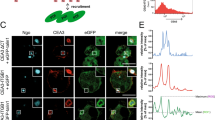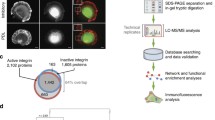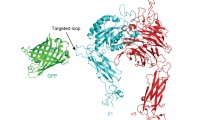Abstract
Integrins are ubiquitous adhesion receptors that are important for signaling and integrating the extracellular matrix and cytoskeleton. The role of cytoplasmic proteins vinculin, focal adhesion kinase (FAK), integrin-linked kinase (ILK), and membrane proteins epidermal growth factor receptor (EGFR) and Notch in altering αPS2CβPS integrin lateral diffusion was measured using single particle tracking (SPT) and RNA interference (RNAi). SPT measures heterogeneous diffusion properties, and RNAi selectively reduces the concentration of a target protein. After systematically reducing the concentration of vinculin, FAK, ILK, EGFR, or Notch, there was a 31 to 80 % increase in the mobile integrin fraction, indicating that these five targeted proteins (or assemblies that contain these proteins) are responsible for immobilizing a fraction of the integrins when all proteins are present at native concentrations. The average diffusion coefficient of all mobile integrins did not change after any of the RNAi treatments, and the percentage of Brownian, directed, or anomalous/constrained trajectories relative to total mobile trajectories did not change after vinculin or EGFR RNAi. However, the fraction of anomalous/constrained trajectories relative to the total mobile trajectories increased 9 to 19 % after FAK, ILK, and Notch RNAi, when the concentration of these proteins was reduced. In the case of FAK, ILK, and Notch, native concentrations of these proteins simultaneously increase the immobile fraction of integrins but decrease the diffusion constraints to those integrins that remain mobile. Comparisons of single receptor and ensemble measurements of diffusion and what is known about the effect of these proteins in altering integrin clustering are discussed.

Membrane and Cytoplasmic proteins that affect the heterogeneous diffusion properties of integrin receptors can be elucidated using RNA interference to reduce the concentration of a single protein combined with single particle tracking measurements at native or reduced protein concentrations. Trajectories exhibit directed, Brownian, or anomalous motion; there is also a fraction of immobile receptor.




Similar content being viewed by others
References
Takada Y, Ye X, Simon S (2007) The integrins. Genome Biol 8(5):215
Plow EF, Haas TA, Zhang L, Loftus J, Smith JW (2000) Ligand binding to integrins. J Biol Chem 275(29):21785–21788
Hynes RO (2002) Integrins: bidirectional, allosteric signaling machines. Cell 110(6):673–687
Giancotti FG, Ruoslahti E (1999) Integrin signaling. Science 285(5430):1028–1032
Streuli CH, Akhtar N (2009) Signal co-operation between integrins and other receptor systems. Biochem J 418(3):491–506
Millard M, Odde S, Neamati N (2011) Integrin targeted therapeutics. Theranostics 1:154–188
Goodman SL, Picard M (2012) Integrins as therapeutic targets. Trends in pharmacological sciences 33(7):405–412
Luo BH, Carman CV, Springer TA (2007) Structural basis of integrin regulation and signaling. Annu Rev Immunol 25:619–647
Xiong JP, Stehle T, Zhang R, Joachimiak A, Frech M, Goodman SL, Arnaout MA (2002) Crystal structure of the extracellular segment of integrin alpha Vbeta3 in complex with an Arg-Gly-Asp ligand. Science 296(5565):151–155
Petit V, Thiery JP (2000) Focal adhesions: structure and dynamics. Biol Cell 92(7):477–494
Kroemker M, Rudiger AH, Jockusch BM, Rudiger M (1994) Intramolecular interactions in vinculin control alpha-actinin binding to the vinculin head. FEBS Lett 355(3):259–262
Turner CE, Glenney JR Jr, Burridge K (1990) Paxillin: a new vinculin-binding protein present in focal adhesions. J Cell Biol 111(3):1059–1068
Menkel AR, Kroemker M, Bubeck P, Ronsiek M, Nikolai G, Jockusch BM (1994) Characterization of an F-actin-binding domain in the cytoskeletal protein vinculin. J Cell Biol 126(5):1231–1240
Humphries JD, Wang P, Streuli C, Geiger B, Humphries MJ, Ballestrem C (2007) Vinculin controls focal adhesion formation by direct interactions with talin and actin. J Cell Biol 179(5):1043–1057
Schaller MD, Otey CA, Hildebrand JD, Parsons JT (1995) Focal adhesion kinase and paxillin bind to peptides mimicking beta integrin cytoplasmic domains. J Cell Biol 130(5):1181–1187
Hannigan GE, Leung-Hagesteijn C, Fitz-Gibbon L, Coppolino MG, Radeva G, Filmus J, Bell JC, Dedhar S (1996) Regulation of cell adhesion and anchorage-dependent growth by a new beta 1-integrin-linked protein kinase. Nature 379(6560):91–96
Brown EJ (2002) Integrin-associated proteins. Curr Opin Cell Biol 14(5):603–607
Schneller M, Vuori K, Ruoslahti E (1997) Alphavbeta3 integrin associates with activated insulin and PDGFbeta receptors and potentiates the biological activity of PDGF. EMBO J 16(18):5600–5607
Woodard AS, Garcia-Cardena G, Leong M, Madri JA, Sessa WC, Languino LR (1998) The synergistic activity of alphavbeta3 integrin and PDGF receptor increases cell migration. J Cell Sci 111(Pt 4):469–478
Soung YH, Clifford JL, Chung J (2010) Crosstalk between integrin and receptor tyrosine kinase signaling in breast carcinoma progression. BMB Rep 43(5):311–318
Miyamoto S, Teramoto H, Gutkind JS, Yamada KM (1996) Integrins can collaborate with growth factors for phosphorylation of receptor tyrosine kinases and MAP kinase activation: roles of integrin aggregation and occupancy of receptors. J Cell Biol 135(6 Pt 1):1633–1642
Moro L, Venturino M, Bozzo C, Silengo L, Altruda F, Beguinot L, Tarone G, Defilippi P (1998) Integrins induce activation of EGF receptor: role in MAP kinase induction and adhesion-dependent cell survival. EMBO J 17(22):6622–6632
Yu X, Miyamoto S, Mekada E (2000) Integrin alpha 2 beta 1-dependent EGF receptor activation at cell-cell contact sites. J Cell Sci 113(Pt 12):2139–2147
Falcioni R, Antonini A, Nistico P, Di Stefano S, Crescenzi M, Natali PG, Sacchi A (1997) Alpha 6 beta 4 and alpha 6 beta 1 integrins associate with ErbB-2 in human carcinoma cell lines. Exp Cell Res 236(1):76–85
Mariotti A, Kedeshian PA, Dans M, Curatola AM, Gagnoux-Palacios L, Giancotti FG (2001) EGF-R signaling through Fyn kinase disrupts the function of integrin alpha6beta4 at hemidesmosomes: role in epithelial cell migration and carcinoma invasion. J Cell Biol 155(3):447–458
Campos LS, Decker L, Taylor V, Skarnes W (2006) Notch, epidermal growth factor receptor, and beta1-integrin pathways are coordinated in neural stem cells. J Biol Chem 281(8):5300–5309
Chen Y, Lagerholm BC, Yang B, Jacobson K (2006) Methods to measure the lateral diffusion of membrane lipids and proteins. Methods 39(2):147–153
Saxton MJ, Jacobson K (1997) Single-particle tracking: applications to membrane dynamics. Annu Rev Biophys Biomol Struct 26:373–399
Arora N, Mainali D, Smith EA (2012) Unraveling the role of membrane proteins Notch, Pvr, and EGFR in altering integrin diffusion and clustering. Anal Bioanal Chem 404(8):2339–2348
Sander S, Arora N, Smith EA (2012) Elucidating the role of select cytoplasmic proteins in altering diffusion of integrin receptors. Anal Bioanal Chem 403(8):2327–2337
Mirchev R, Golan DE (2001) Single-particle tracking and laser optical tweezers studies of the dynamics of individual protein molecules in membranes of intact human and mouse red cells. Blood Cells Mol Dis 27(1):143–147
Pralle A, Keller P, Florin EL, Simons K, Horber JK (2000) Sphingolipid-cholesterol rafts diffuse as small entities in the plasma membrane of mammalian cells. J Cell Biol 148(5):997–1008
Leitner DM, Brown FL, Wilson KR (2000) Regulation of protein mobility in cell membranes: a dynamic corral model. Biophys J 78(1):125–135
Sako Y, Kusumi A (1994) Compartmentalized structure of the plasma membrane for receptor movements as revealed by a nanometer-level motion analysis. J Cell Biol 125(6):1251–1264
Edidin M, Zuniga MC, Sheetz MP (1994) Truncation mutants define and locate cytoplasmic barriers to lateral mobility of membrane glycoproteins. Proc Natl Acad Sci U S A 91(8):3378–3382
Dibya D, Sander S, Smith EA (2009) Identifying cytoplasmic proteins that affect receptor clustering using fluorescence resonance energy transfer and RNA interference. Anal Bioanal Chem 395(7):2303–2311
Bunch TA, Grinblat Y, Goldstein LS (1988) Characterization and use of the Drosophila metallothionein promoter in cultured Drosophila melanogaster cells. Nucleic Acids Res 16(3):1043–1061
Bunch TA, Brower DL (1992) Drosophila PS2 integrin mediates RGD-dependent cell-matrix interactions. Development 116(1):239–247
Zavortink M, Bunch TA, Brower DL (1993) Functional properties of alternatively spliced forms of the Drosophila PS2 integrin alpha subunit. Cell Adhes Commun 1(3):251–264
Mainali D, Smith EA (2013) The effect of ligand affinity on integrins' lateral diffusion in cultured cells. Eur Biophys J 42(4):281–290
Clemens JC, Worby CA, Simonson-Leff N, Muda M, Maehama T, Hemmings BA, Dixon JE (2000) Use of double-stranded RNA interference in Drosophila cell lines to dissect signal transduction pathways. Proceedings of the National Academy of Sciences 97(12):6499–6503
Smith EA, Bunch TA, Brower DL (2007) General in vivo assay for the study of integrin cell membrane receptor microclustering. Anal Chem 79(8):3142–3147
Sbalzarini IF, Koumoutsakos P (2005) Feature point tracking and trajectory analysis for video imaging in cell biology. J Struct Biol 151(2):182–195
Saffman PG, Delbruck M (1975) Brownian motion in biological membranes. Proc Natl Acad Sci U S A 72(8):3111–3113
Qian H, Sheetz MP, Elson EL (1991) Single particle tracking. Analysis of diffusion and flow in two-dimensional systems. Biophys J 60(4):910–921
Kevin B, Dries V, Jo D, Stefaan De S (2010) Single particle tracking. In: Nanoscopy and multidimensional optical fluorescence microscopy. Chapman and Hall, London, pp 5–1 to 5–17
Nirmal M, Dabbousi BO, Bawendi MG, Macklin JJ, Trautman JK, Harris TD, Brus LE (1996) Fluorescence intermittency in single cadmium selenide nanocrystals. Nature (London) 383:802–804
Dahan M, Levi S, Luccardini C, Rostaing P, Riveau B, Triller A (2003) Diffusion dynamics of glycine receptors revealed by single-quantum dot tracking. Science 302(5644):442–445
Saxton MJ (1997) Single-particle tracking: the distribution of diffusion coefficients. Biophys J 72(4):1744–1753
Feder TJ, Brust-Mascher I, Slattery JP, Baird B, Webb WW (1996) Constrained diffusion or immobile fraction on cell surfaces: a new interpretation. Biophys J 70(6):2767–2773
Slattery JP (1995) Lateral mobility of Fc[epsilon]RI on rat basophilic leukemia cells as measured by single particle tracking using a novel bright fluorescent probe. Cornell University, Ithaca
Ghosh RN, Webb WW (1994) Automated detection and tracking of individual and clustered cell surface low density lipoprotein receptor molecules. Biophys J 66(5):1301–1318
Boutros M, Kiger AA, Armknecht S, Kerr K, Hild M, Koch B, Haas SA, Paro R, Perrimon N (2004) Genome-wide RNAi analysis of growth and viability in Drosophila cells. Science 303(5659):832–835
Bjorklund M, Taipale M, Varjosalo M, Saharinen J, Lahdenpera J, Taipale J (2006) Identification of pathways regulating cell size and cell-cycle progression by RNAi. Nature 439(7079):1009–1013
Bettencourt-Dias M, Giet R, Sinka R, Mazumdar A, Lock WG, Balloux F, Zafiropoulos PJ, Yamaguchi S, Winter S, Carthew RW, Cooper M, Jones D, Frenz L, Glover DM (2004) Genome-wide survey of protein kinases required for cell cycle progression. Nature 432(7020):980–987
Schmidt EE, Pelz O, Buhlmann S, Kerr G, Horn T, Boutros M (2013) GenomeRNAi: a database for cell-based and in vivo RNAi phenotypes, 2013 update. Nucleic Acids Res 41:D1021–D1026
Chen Q, Jagannathan S, Reid DW, Zheng T, Nicchitta CV (2011) Hierarchical regulation of mRNA partitioning between the cytoplasm and the endoplasmic reticulum of mammalian cells. Mol Biol Cell 22(14):2646–2658
Lerner RS, Seiser RM, Zheng T, Lager PJ, Reedy MC, Keene JD, Nicchitta CV (2003) Partitioning and translation of mRNAs encoding soluble proteins on membrane-bound ribosomes. RNA 9(9):1123–1137
Sander S (2012) Development of fluorescence-based methods to study the effect of cytoplasmic proteins, cholesterol, and extracellular ligand on integrin diffusion and clustering in single cells. Iowa State University, Ames
Saunders RM, Holt MR, Jennings L, Sutton DH, Barsukov IL, Bobkov A, Liddington RC, Adamson EA, Dunn GA, Critchley DR (2006) Role of vinculin in regulating focal adhesion turnover. Eur J Cell Biol 85(6):487–500
Coll JL, Ben-Ze'ev A, Ezzell RM, Rodriguez Fernandez JL, Baribault H, Oshima RG, Adamson ED (1995) Targeted disruption of vinculin genes in F9 and embryonic stem cells changes cell morphology, adhesion, and locomotion. Proc Natl Acad Sci U S A 92(20):9161–9165
Decker L, Baron W, Ffrench-Constant C (2004) Lipid rafts: microenvironments for integrin-growth factor interactions in neural development. Biochem Soc Trans 32(Pt3):426–430
Runz S, Mierke CT, Joumaa S, Behrens J, Fabry B, Altevogt P (2008) CD24 induces localization of beta1 integrin to lipid raft domains. Biochem Biophys Res Commun 365(1):35–41
Simons K, Toomre D (2000) Lipid rafts and signal transduction. Nat Rev Mol Cell Biol 1(1):31–39
Wang R, Bi J, Ampah KK, Zhang C, Li Z, Jiao Y, Wang X, Ba X, Zeng X (2013) Lipid raft regulates the initial spreading of melanoma A375 cells by modulating β1 integrin clustering. Int J Biochem Cell Biol 45(8):1679–1689
Acknowledgments
This work is supported by the National Science Foundation under Grant CHE-0845236.
Author information
Authors and Affiliations
Corresponding author
Rights and permissions
About this article
Cite this article
Mainali, D., Smith, E.A. Select cytoplasmic and membrane proteins increase the percentage of immobile integrins but do not affect the average diffusion coefficient of mobile integrins. Anal Bioanal Chem 405, 8561–8568 (2013). https://doi.org/10.1007/s00216-013-7279-1
Received:
Revised:
Accepted:
Published:
Issue Date:
DOI: https://doi.org/10.1007/s00216-013-7279-1




